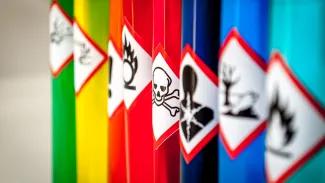Safety is of the utmost importance in any work environment. That is why companies should be careful about exposure to harmful substances and gases: CMR chemicals. CMR stands for Carcinogenic, Mutagenic and Reprotoxic.
The Dutch Ministry of Social Affairs and Employment (Sociale Zaken en Werkgelegenheid) releases a list of CMR chemicals: the SZW list. The Ministry updates and releases the SZW list twice a year.
The list contains all substances that can cause cancer, substances that can cause genetic defects, and substances that could be harmful to reproduction.
Protect Your People
Companies are legally obliged to protect their employees against the harmful effects of dangerous and toxic substances. According to the Dutch labour laws, employers are obliged to identify and list all harmful substances that their employees could be exposed to. This is called a Risico Inventarisatie en Evaluatie (RI&E), which translates into Risk Identification and Evaluation. There are guidelines and rules when it comes to exposure to dangerous substances. For the substances on the SZW list, there are even stricter rules. Some are even entirely forbidden.
Safety (Un)Loading Containers and Trucks
SZW and CMR substances are regularly found in shipping containers and trailers. Some of the most commonly found gases are Formaldehyde, Ethylene Oxide, and Benzene. Ethylene Oxide, for example, can’t be seen or smelled, which is one of the reasons it is so hazardous.
There is a standard list of substances published by the Dutch Sector Institute for Transport and Logistics for which containers and trailers are measured. That list is limited, and some of the hazardous substances are not on that list.
Customs Support Measures for All Hazardous Gases
The traditional technique to detect and measure gas in containers uses gas detection tubes and sensors. This technique has several disadvantages. It is costly, time-consuming, and can potentially have a standard deviation of up to 20 per cent. There are also only a limited number of target gases that can be measured using this technique.
A more sophisticated technique is the Gasmet FTIR technique. One of the most significant advantages of this technique is that FTIR analyzers can detect hundreds of components simultaneously instead of just one or a limited number. The test results tell you precisely what gases are in a container and in what quantities. The FTIR analyzer works fast and delivers transparent and precise reproducible results, and it does so in just a few minutes. The results are real-time. Each gas has its infrared spectrum, which the analyzer can read to determine what gas is in the container.
One of the core values of Customs Support is sustainability, which is why we prefer using an FTIR analyzer for gas measurements. This technique also uses no consumables, which minimizes waste.
You can read more on Gas Measurement in these articles:
- The Importance of Measuring Gas in Shipping Containers
- The Importance of Measuring Gas in Confined Spaces
Being Safe is Being Sure. Ask an Expert.
If you have any questions about gas-related matters or need support with fumigation or degassing of your shipment, a risk analysis, or any other gas-related issue, please contact one of our trained and experienced specialists. They are happy to help. Customs Support: Take the load off your mind!











